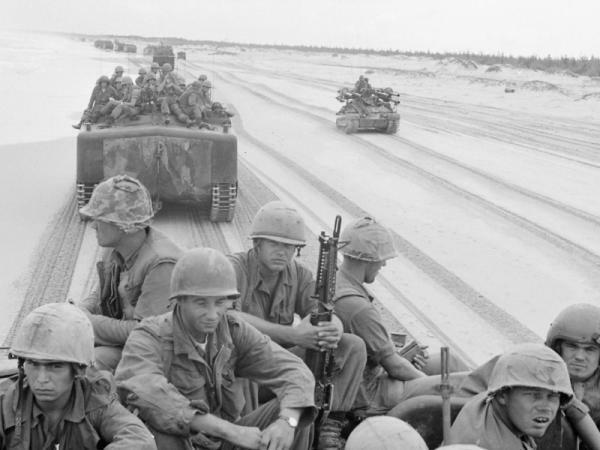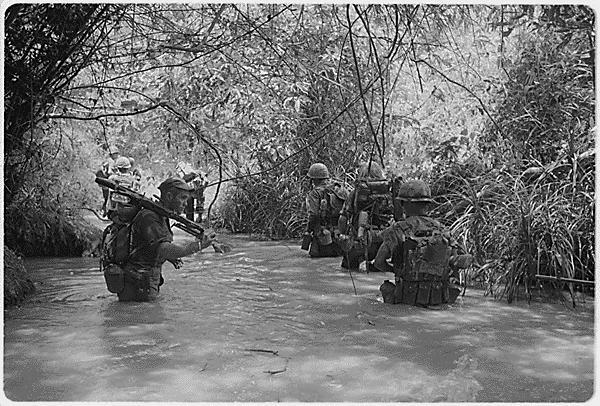Development of the Vietnam War

The Vietnam War is one of the best known of all those that occurred in the 20th century, due in large part to the great importance it had for the world and especially, apart from the Vietnamese themselves, for the society American.
Its development is usually divided into 4 different phases and, therefore, in this lesson from a TEACHER we are going to talk about the development of the Vietnam War through these 4 very important phases.
Index
- First phase of the Vietnam War: the dominance of North Vietnam
- Second phase of the development of the Vietnam War: the United States enters the conflict
- Third phase of the development of the Vietnam War: the Northern offensive and Vietnamization
- Fourth phase of the development of the Vietnam War: the end of the war
First phase of the Vietnam War: the dominance of North Vietnam.
The first phase of the Vietnam War was the one that took place between years 1959 and 1964. Since the mid-1950s a group called the Vietnam National Liberation Front, also called
Vietcong, had begun to intervene in South Vietnam, being supported by weapons by North Vietnam.The armed actions of the Vietcong were a reaction against the government of the region and its great corruption, although It also influenced the fact that the communist ideas of a large part of the population collided with the interests of the rulers from the south. The idea of the Vietcong was to overthrow the government and unify the two parts of Vietnam into a single state.
The Vietcong was superior to the troops of the south, reason why they did not take in obtaining fast victories. A few months later the first Americans arrived, but they were not troops, just military advisers that the Americans had sent to advise the south. Soldiers from the south received military training and weapons, but that did not stop the Vietcong from continuing to win battles and conquer different territories in South Vietnam.
The many victories of the south caused in 1964 more than half of South Vietnam was under the control of the Vietcong, being then when the United States decided that it was time to intervene in the war.
To put yourself even better at the beginning of this war, you can refer to the lesson in which we talk about the Causes of the Vietnam War.

Second phase of the development of the Vietnam War: the United States enters the conflict.
The second phase of the Vietnam war is located between 1964 and 1968, and its main characteristic is the entry of United States troops in the conflict. The victories of the Vietcong were more and more numerous and the United States only wanted a small excuse to intervene.
In August 1964 the Gulf of Tonkin incident, when the destroyer USS Maddox was attacked by a group of the Vietcong. Two days later the destroyer was attacked again, being then when President Johnson decided to initiate the attack on Vietnam.
The entry of the United States brought results almost immediately, and South Vietnam began to regain part of its territory.
In these years, the first battles between Americans and Vietnamese took place, such as that of the Ia Drang Valley or Operation Starlight, which showed that the US troops were far superior to the Vietnamese. To all this was added Operation Rolling Thunder, which consisted of the bombardment of North Vietnam, to destroy part of the country and make the Vietcong surrender.
On the other hand, the Vietcong decided that it was best to move to a guerrilla warfare, since by knowing the territory better they would have the upper hand. The Vietnamese built tunnels everywhere, in which they hid to attack the Americans by surprise. At the same time they used a road, the so-called Ho Chi Minh route, which was used to supply the Vietcong by the northern government.
Third phase of the development of the Vietnam War: the Northern offensive and Vietnamization.
The third phase of the Vietnam War is the located between 1968 and 1973, being the moment in which the Vietcong managed to turn the war around, and American society began to protest to continue with the battles.
In 1968, the Vietcong carried out two huge offensives against American troops. The first was Khe Sanh, a continuous bombardment by the Vietcong against a base protected by the Green Berets, which managed to hold out for more than 70 days before losing. This attack is considered the only defeat of the United States in the war.
The second attack was the Tet offensive, being an attack on a large number of provincial capitals in South Vietnam at the same time by the Vietcong. The offensive brought massive casualties on both sides, but ended in the American victory. Even with the victory this battle was a turning point for the Americans, as many Americans had died, producing an enormous amount of complaints on the part of the American society, that wanted to see finished the war.
After these battles, and the arrival of Richard Nixon to the presidency, the call began vietnamization, which consisted of preparing and strengthening the armies of South Vietnam, and then gradually withdrawing US troops. All of this was largely due to the fact that public opinion was totally against the war.
The plan did not work out all that well, as the war was not on track well enough to leave Vietnam. Still, the situation was unsustainable and US troops began a slow process of withdrawing from Vietnam.
In 1973 the United States signed the Paris Peace Accords, stopping the fire and withdrawing their troops. So the Vietnam War was again a civil conflict between the south and the north.
Fourth phase of the development of the Vietnam War: the end of the war.
To conclude this lesson on the development of the Vietnam war, we must talk about the conclusion of the conflict.
The fourth and final phase of the Vietnam War it happened between 1973 and 1975, being the period in the north won the war, unifying Vietnam in a single country. After the withdrawal of the United States the government of North Vietnam gathered all the troops it could get, looking for a last offensive that would win the war.
With all this came the spring offensive, being a massive attack by the Vietcong and northern troops against what was left of the southern army. The offensive ended with a total surrender and the fall of the southern capital, Saigon.
With all this, the Vietnam War ended, unifying both regions in a single Vietnam under the communist government that ruled North Vietnam.
To expand more information on this war, we recommend you review the lesson of the Summary of the Vietnam Waras well as the lesson on Consequences of the Vietnam War.

If you want to read more articles similar to Development of the Vietnam War, we recommend that you enter our category of Story.



